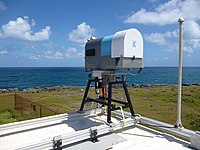
Photo from wikipedia
The high-frequency airborne microwave and millimeter-wave radiometer (HAMMR) is a cross-track scanning airborne radiometer instrument with 25 channels from 18.7 to 183.3 GHz. HAMMR includes: low-frequency microwave channels at 18.7,… Click to show full abstract
The high-frequency airborne microwave and millimeter-wave radiometer (HAMMR) is a cross-track scanning airborne radiometer instrument with 25 channels from 18.7 to 183.3 GHz. HAMMR includes: low-frequency microwave channels at 18.7, 23.8, and 34.0 GHz at two linear-orthogonal polarizations; high-frequency millimeter-wave channels at 90, 130 and 168 GHz; and millimeter-wave sounding channels consisting of eight channels near the 118.75 GHz oxygen absorption line for temperature profiling and eight additional channels near the 183.31 GHz water vapor absorption line for water vapor profiling. HAMMR was deployed on a twin otter aircraft for a west coast flight campaign (WCFC) from November 4–17, 2014. During the WCFC, HAMMR collected radiometric observations for more than 53.5 h under diverse atmospheric conditions, including clear sky, scattered and dense clouds, as well as over a variety of surface types, including coastal ocean areas, inland water and land. These measurements provide a comprehensive dataset to validate the instrument.
Journal Title: IEEE Journal of Selected Topics in Applied Earth Observations and Remote Sensing
Year Published: 2019
Link to full text (if available)
Share on Social Media: Sign Up to like & get
recommendations!